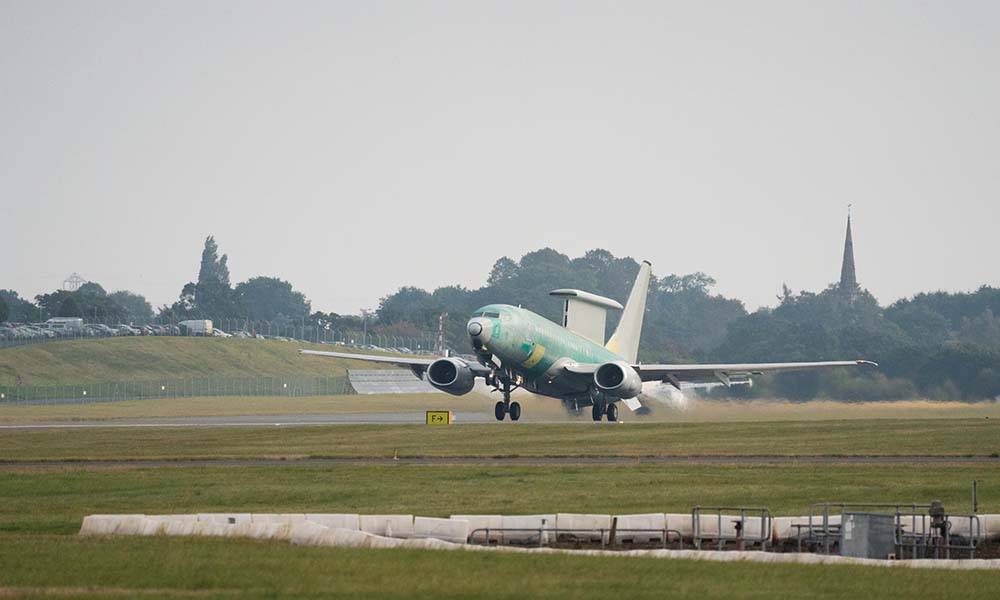Aviation
Boeing Completes First Flight of UK E-7 Wedgetail Aircraft

In a major advancement for the Royal Air Force’s (RAF) airborne surveillance capabilities, Boeing has successfully completed the first flight of the UK’s E-7 Wedgetail, marking a significant milestone in the program’s test and evaluation phase.
The flight, conducted by a Boeing flight-test crew, took place at Birmingham Airport and involved a series of functional checks on the aircraft, confirming its operational readiness.
Qatar Airways bans these new Electronic Devices on plane
Currently unpainted, the aircraft is one of three Boeing 737 Next Generation (NG) planes undergoing modification at Birmingham by a dedicated team of more than 100 skilled engineers from STS Aviation Services. This phase involves transforming the aircraft into a state-of-the-art airborne early warning and control (AEW&C) platform.
The E-7 Wedgetail stands out as a combat-proven asset capable of detecting and identifying adversarial targets at long range while simultaneously tracking multiple airborne and maritime threats. Its Multi-role Electronically Scanned Array (MESA) sensor provides 360-degree coverage, granting the RAF a critical command-and-control advantage in multi-domain operations.
This airline will be billed $790 for each customer complaint resolved
The aircraft will eventually be stationed at RAF Lossiemouth in Scotland, where preparations are already underway to support the E-7 fleet’s induction, with Boeing’s local suppliers and contractors nearing completion of the necessary infrastructure. The UK E-7 fleet is set to provide a considerable boost to the RAF’s situational awareness and operational capabilities.
Furthermore, the RAF’s involvement in a tri-lateral partnership with the Royal Australian Air Force (RAAF) and the U.S. Air Force (USAF) will enhance the interoperability, capability development, evaluation, testing, sustainment, and training of the Wedgetail platform, ensuring seamless integration and operation across allied forces.
Currently, the E-7 is operated by the RAAF, the Republic of Korea Air Force, and the Turkish Air Force. Boeing is also building two rapid prototype E-7 aircraft for the USAF, and in 2023, NATO selected the E-7 to fulfill its Airborne Early Warning & Control (AEW&C) mission, underscoring the aircraft’s growing prominence in global defense networks.
This expanding global E-7 fleet not only ensures mission readiness and interoperability but also provides significant lifecycle cost advantages. Later this autumn, following extensive flight testing and evaluations, the aircraft will head to a paint facility to receive its distinctive RAF livery, symbolizing its formal integration into the UK’s defense fleet.
This milestone highlights Recently boeing 797 continued commitment to delivering cutting-edge defense solutions and marks a new chapter for the RAF’s airborne surveillance capabilities.

Aviation
COMAC Unveils Plans for the C929 to Rival Airbus and Boeing

After the success of China’s first C919 aircraft, the country is setting its sights on developing a larger plane. COMAC (Commercial Aircraft Corporation of China) has officially confirmed plans to build a widebody aircraft, marking a significant step in its aircraft lineup.
Traditionally, Airbus and Boeing dominate the widebody aircraft market, with decades of expertise in developing planes and engines capable of carrying heavy payloads. China, which currently relies on imported engines, is now aiming to challenge these giants with its own widebody jet, the C929, designed to compete with the Airbus A350 and Boeing 777.
American Airlines Is Looking for Flight Attendants: Apply Now
The C929 will be China’s first independently developed long-range widebody aircraft. It adheres to international airworthiness standards and boasts independent intellectual property rights. The baseline version is designed to seat 280 passengers and offers a range of 12,000 kilometers, catering to global demand for both regional and international air travel.
Russia, which also needs reliable narrowbody and widebody aircraft, could become a key customer for the C929. Additionally, China plans to target the broader Asian market as it continues to expand its aviation capabilities.
Close Call at Heathrow: BA Flight Narrowly Escapes Drone Collision
China’s aviation progress includes the ARJ21 (now called C909), a regional jet with 100 seats for shorter routes, and the C919, a narrowbody jet with 180 seats designed to rival the Boeing 737 MAX and Airbus A320. Both models have found increasing demand in the domestic market.
At China’s largest air show in Zhuhai, COMAC announced that Air China will be the launch customer for the C929 widebody jet, though details about order size and delivery timelines were not disclosed.
Other major deals announced by COMAC include:
- Hainan Airlines: Firm orders for 60 C919 and 40 C909 regional jets.
- Colorful Guizhou Airlines: 30 C909 jets, with 20 firm orders and 10 provisional agreements.
The C929, renamed from the CR929 after Russia withdrew from the joint development project in 2023, is expected to carry 280–400 passengers with a range of 12,000 kilometers, competing directly with Boeing’s 787 Dreamliner.
According to COMAC’s deputy general manager, Tong Yu, the first fuselage section of the C929 is expected by September 2027, with prototype test flights anticipated soon after.
-

 Aviation2 months ago
Aviation2 months agoMicrosoft Flight Simulator Raises $3 Million to Bring Back the An-225 Mriya
-

 Airlines2 months ago
Airlines2 months agoQantas Engineers Stage Walkout Over Cost of Living Concerns
-

 Airlines2 months ago
Airlines2 months agoQatar Citizens Can Travel to the United States Without a Visa
-

 Aviation2 months ago
Aviation2 months agoQatar Airways bans these new Electronic Devices on plane
-

 Airlines2 months ago
Airlines2 months agoJapan Airlines Rolls Out Free Domestic Flights to International Passengers
-

 Defence2 months ago
Defence2 months agoWhich Country Has the Largest Fleet of Fighter Aircraft?
-

 Airport2 months ago
Airport2 months agoWestern Sydney Airport Welcomes Its First Plane After 6 Years of construction
-

 Travel2 months ago
Travel2 months agoQatar Airways Launches Four Additional Flights from Amsterdam








